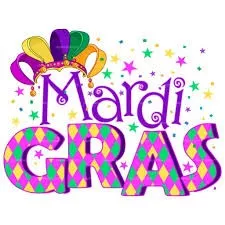Feb 13, 2018
You may be familiar with the beads, the king cakes, and the masked celebrations — but you’ll never guess at the history behind these and other traditions from axexandani.com.
Fat Tuesday, also known as Mardi Gras, is the celebration that marks the day before Lent, a time of sacrifice for the 40 days leading up to Easter. Nowhere is this carnival celebrated with more enthusiasm than in New Orleans, Louisiana. The event — more than 300 years old — is packed with traditions. We’re inspired by the deep significance behind them, and we think you will be, too.
Wearing Masks
On Fat Tuesday, revelers on parade floats and in the streets wear elaborate masks covered in sequins, jewels, and/or feathers to disguise their faces. This tradition dates back to the first Mardi Gras at the turn of the 17th century. In that era, there were strict rules about proper social conduct — and masks allowed partygoers to shed societal expectations, where upper class and lower class could mingle for a shared moment of merriment.
Throwing Beaded Necklaces
Credit for this colorful tradition goes to the first Rex, the elected King of Carnival. In 1872, the Mardi Gras theme had three symbolic colors: purple for justice, green for faith, and gold for power, all in honor of visiting Grand Duke Alexei Alexandrovich of Russia. The idea was to toss the glass beads to spectators who appeared to embody these traits. The colors stuck — and in the decades that followed, the Krewe of Rex (one of two social clubs that run Mardi Gras) threw colorful glass beads, doubloons, and trinkets to the crowd. Most modern Mardi Gras beads are made of plastic, but a few “throws” are still handcrafted glass beaded necklaces.
Zulu Coconuts
Is there any Mardi Gras throw more prized than a Zulu coconut? The Zulu coconut tradition began in the early 1900s with the first historically African-American krewe. Lacking the funds to buy and throw glass beads to the crowd, they opted for inexpensive coconuts. Over the years, this tradition has evolved and today the tropical fruits are brightly painted, embellished with glitter, and handed to spectators rather than thrown (flying coconuts = danger!).
King Cakes
During Mardi Gras, bakeries across New Orleans sell out of king cakes iced in official Mardi Gras green, purple, and gold. These round pastries commemorate the Christian Epiphany, or Twelfth Night, which marks the day that the Wise Men visited the baby Jesus. Choose your slice wisely: The “lucky” person whose piece of cake contains the tiny plastic baby (representing Jesus) is responsible for buying next year’s cake!
The History Behind Mardi Gras Beads
 While Mardi Gras means many things to many people according to mardigrasday.com, one item that is incorporated into almost every Mardi Gras celebration is beads of every size, shape, and color.
While Mardi Gras means many things to many people according to mardigrasday.com, one item that is incorporated into almost every Mardi Gras celebration is beads of every size, shape, and color.
But how did this tradition come to be? And more importantly what do those beads stand for? The bead phenomena is a relatively new one considering that while the first Mardi Gras parade in New Orleans occurred in the 1830s, it wasn’t until the Rex parade threw inexpensive handmade glass necklaces sometime in the 1920s that the tradition was born.
Since that time the Mardi Gras bead industry has grown larger with each year and the cries of “throw me something, Mister!” that parade goers yell to catch the attention of the floats passing by gets louder along with more creative ideas to secure those precious trinkets.
However, many people don’t know that the traditional Mardi Gras bead color scheme: purple, green, and gold holds special meaning as well. The Purple, represents justice; the Green symbolizes faith; and the Gold exemplifies power. Though as the celebrations grow larger with each year that passes, beads and necklaces now come in every shape and color imaginable.
Also, parade Krewes each year have sought out other trinkets to toss to the crowds, in addition to the beads, to make their parade unique. In recent years Frisbees, plastic cups, and even doubloons all marked with the specific parade Krewes name and logo have been thrown to thousands of Mardi Gras goers. Though one of the more unique and sought-after throws, among Mardi Gras aficionados, is distributed by the Zulu Aid & Pleasure club, which distributes hand-painted coconuts. In recent years the Zulus have needed to pass out the coconuts in bags, rather than throwing them due to safety concerns as they weigh about 11 lbs. each!
But the beads and necklaces remain the most popular Mardi Gras souvenir. And it is not uncommon for members of parade Krewes to spend an average of $800-$2,000 per parade ride on the beads that they will toss over the course of their parade route. Also, Krewes must submit their bead orders in September to ensure that they will be ready for Carnival season early the next year.
In recent years the distribution of beads has been equated to rowdy behavior. This has mainly involved men demanding that women show certain parts of their bodies to earn their beads. Many long-time Mardi Gras attendees will point out that this mainly happens in the French Quarter and not along the actual parade route, where the fun and true purpose of Mardi Gras continues to prosper.
Beads are getting longer and bigger. The most popular size today is about 33? long and is ½” in diameter.
All images: clipartpanda.com
Share this article with friends!
Tags:
#mardi#gras,#beads,#masks,#parades,#starzpsychics.com,#starz#advisors


